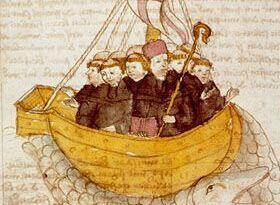Goleen on the way to Mizen Head. PHOTOS BY MARGARET M. JOHNSON
IRELAND HOPPING | Margaret M. Johnson.
Part II
I recently spent a few days in Bantry, a lively harbor town on the main N71 touring route that stretches from Cork to Kerry. It’s one of the highlights of the Wild Atlantic Way, and as tourism officials there like to call it, “the jewel at the head of one of Europe’s deepest natural harbors.” It’s also the gateway to surrounding Beara, Sheep’s Head, and Mizen peninsulas, so you can expect glorious, rugged scenery along with amazing food at local Bantry spots and beyond, like Restaurant Chestnut in Ballydehob.
When I first learned back in October that Ireland received three new Michelin stars (bringing the total for the island to an all-time high of sixteen), I was amazed that three of the stars were awarded to restaurants in County Cork. And I was thrilled that I would be close enough to, hopefully, reserve a table at Restaurant Chestnut. With only eighteen seats, yes, only eighteen, I wanted to be sure I’d get two of them during my Bantry stay; lucky for me and my friend, we did!

Rob Krawczyk and Elaine Fleming.
STARRY MENU
Ballydehob (Béal Átha an Dá Chab) is a lively little village situated at the gateway to the Mizen Peninsula about 10 miles from Bantry. While I love casual dining, when you’re this close to a white-tablecloth, Michelin star-experience, you make the investment. The restaurant, which opened in March 2018 and gained its star only seven months later, is located in a character-filled former pub on the slope of Staball Hill. Its unique position gives its interior a little quirkiness, like a few extra steps-up and a few steps-down, but this only adds to its already unique interior. If you can imagine a traditional Irish pub transformed into an elegantly designed restaurant, this is Restaurant Chestnut.
Chef Rob Krawczyk, who grew up in nearby Schull, is in charge of things here, and he attributes much of his culinary success to his parents. He grew up in a home where the kitchen was the center of life, and his cooking style is influenced by his parent’s culinary and artistic heritage. His father, Frank, was well known in the area for curing, smoking, and fermenting foods, elements that feature prominently in the menu here. After living away, Rob was drawn home again by West Cork’s rich larder, a factor not lost on his nature-inspired, seasonally-driven menu. Local, local, local is the byword here, with herbs, flowers, vegetables, meat, and fish all sourced, grown, picked, and foraged from the surrounding countryside — even the serving dishes are made by local artisans. According to Krawczyk, his dishes are presented as close to nature as possible allowing an honest encounter between chef and diner.

His tasting menu (85€/$95), which was featured during our visit and artfully presented by Elaine Fleming, began with a small loaf of homemade brown bread and cultured butter and progressed to celeriac and whipped goats cheese, chou with beef and pickles, and a beautifully-appointed garden salad. It was followed by Roaringwater Bay mussels with seaweed and tapioca, red mullet with celery root and truffle, and duck with potato cooked in seaweed and butter. The meal ended with designer desserts that included chocolate and rhubarb, and sheep’s yogurt with clove and brown butter!
And since we were “investing,” we indulged in the wines for the tasting menu (35€/$40): a Charles Andrieu Cava from Spain to accompany the breads and snacks; a “Paulessen” Reisling from Germany to accompany the first two courses; a crisp Portuguese Alvarinho followed for the fish main course; Dehesa la Granja from Spain was served with the meat main course; and for the final dessert course, we finished with a yummy Elysium, Black Muscat from California — beyond wonderful in lovely Ballydehob!

BROWN SODA BREAD
MAKES 1 LOAF
At Restaurant Chestnut (www.restaurantchestnutwestcork.ie), this delicious brown bread appears as a little loaf-for-two with cultured butter.
2 cups coarse organic whole wheat flour
2 1/4 cups organic white flour
1 tablespoons wheat bran
1 tablespoon wheat germ
1 1/2 tablespoons brown sugar
1 tablespoon salt
1 1/2 teaspoons baking soda
1 1/2 cups buttermilk
Softened butter, for serving
1. Preheat oven to 350°F. Grease 7-inch loaf pan and dust with flour; tap out excess.
- In a large bowl, whisk together flours, wheat bran, wheat germ, brown sugar, and salt. Sift in baking soda.
- Make a well in center, pour in buttermilk, and with a wooden spoon stir until blended (Add additional buttermilk if the mixture if needed; do not over mix as it can make the bread heavy).
4. Transfer mixture to prepared pan and bake for 30 to 40 minutes, or until a skewer inserted into center comes out clean. Alternately, tap on bottom of bread to see if it sounds hollow. Let cool completely on a wire rack before cutting into slices.
Margaret Johnson’s “Recipes” page expands this year to “Ireland Hopping: Adventures in Food, Drink, and Travel.” For further details on her work or to order a signed cookbook, visit www.irishcook.com.









